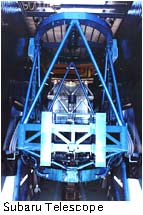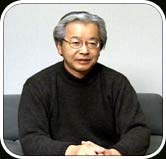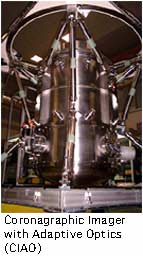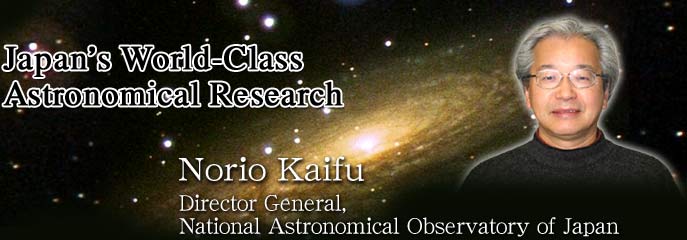 |
 |
 |
 |


File size : 12MB
Format : MPEG |
|
Doctor of Science (Tokyo University)
Dr. Kaifu specializes in radio-wave astronomy and infrared astronomy. He was involved in building the Nobeyama Radio Observatory, which includes a 45-meter radio telescope. Later he was the director of the Subaru telescope project, located in Hawaii. He was awarded the Japan Academy Prize for research on interstellar matter (1997), and the Nishina Memorial Prize for cultivation of Millimeter astronomy (1987). His best-known publications are: Humans in Space History (Kodansha Plus a Bunko), Mysteries of Space: How Far We Have Come (Shin Nihon Shuppan, 1995), and Poetry of Space (Chuko Shinsho), among many others.
Q. What areas of research is the National Astronomical Observatory of Japan (NAOJ) currently looking into, and what directions is it focusing on for the future?
NAOJ is a unique integrated research institute that covers almost all areas of astronomy. We study radio waves, optical infrared rays and gravity waves, as well as astronomical theories and geophysics. Therefore, we don’t particularly limit the research we conduct. For example, the Subaru telescope, which is currently our core piece of equipment, is used for research on almost all astronomical phenomena, from the solar system to space theory. The same is true of the Nobeyama radio telescope.
 Having said that, there are definitely some fields that our research groups are interested in developing using the Subaru telescope. For example, it can be used for observation of the early stages of the universe’s existence. The telescope is outstanding for viewing deep space. A celestial body viewed at such a great distance is extremely old. So, by finding as many of them as possible, we will be able to study phenomena that occurred when our galaxy was born, and at the early stages of the expansion of the universe. Having said that, there are definitely some fields that our research groups are interested in developing using the Subaru telescope. For example, it can be used for observation of the early stages of the universe’s existence. The telescope is outstanding for viewing deep space. A celestial body viewed at such a great distance is extremely old. So, by finding as many of them as possible, we will be able to study phenomena that occurred when our galaxy was born, and at the early stages of the expansion of the universe.
Also, a new large-scale telescope called ALMA - Atacama Large Millimeter / Submillimeter Array - will be built through international collaboration. It will be able not only to observe deep space, but also to study the history of the birth and formation of planets similar to Earth. Many planets orbit around a fixed star, the Sun, and that is the solar system. The Earth is part of this, and we call it a planetary system. Recent research has found that, in fact, many planetary systems exist in space. You see many shining stars in the sky, and we can now assume that there is a planet circling around one out of every ten stars. I think studying the history of those planets’ birth, and the possibility of discovering a planet that could support life, will be the core astronomical themes of the 21st century, in a way more so than space theory.
|


File size : 6MB
Format : MPEG |
|
Q. What fields are you personally interested in?
I’m interested in planets and life in space; planets that circle around other stars, and how life could form on them. I believe everyone is interested in these subjects.
 One piece of research conducted using the Nobeyama radio telescope was to study materials formed in a cold cloud, that is, a dark nebula. We’re finding out that it has a lot of organic matter. The origin of living creatures is protein turning into genes. Everything originated in organic matter, meaning carbon compounds. We’re finding out that a lot of such organic matter exists in space. Nobody would have imagined it 30 years ago, but the invention of radio telescopes started revealing this fact, and in the early 1980s, when I started observation with the Nobeyama radio telescope, astronomers were just beginning to make such discoveries. One piece of research conducted using the Nobeyama radio telescope was to study materials formed in a cold cloud, that is, a dark nebula. We’re finding out that it has a lot of organic matter. The origin of living creatures is protein turning into genes. Everything originated in organic matter, meaning carbon compounds. We’re finding out that a lot of such organic matter exists in space. Nobody would have imagined it 30 years ago, but the invention of radio telescopes started revealing this fact, and in the early 1980s, when I started observation with the Nobeyama radio telescope, astronomers were just beginning to make such discoveries.
So, back then I was already feeling that I would be able to study the flow from organic material to life in space. A dark nebula, which includes organic matter, gradually forms a planet, and next, life is born. And so, for the Subaru telescope, I submitted a proposal for new equipment, the CIAO (Coronagraphic Imager with Adaptive Optics), that would take images of a dark celestial body neighbouring a bright one. This was done with the anticipation that, if there are planets around other stars, Subaru would be able to find them. When the design for the Subaru began, nobody knew there were planets around other stars. It has been up to the younger generation to build the CIAO, and they continue to search, in hopes of observing a distant planet revolving around another star. |
|
 |

